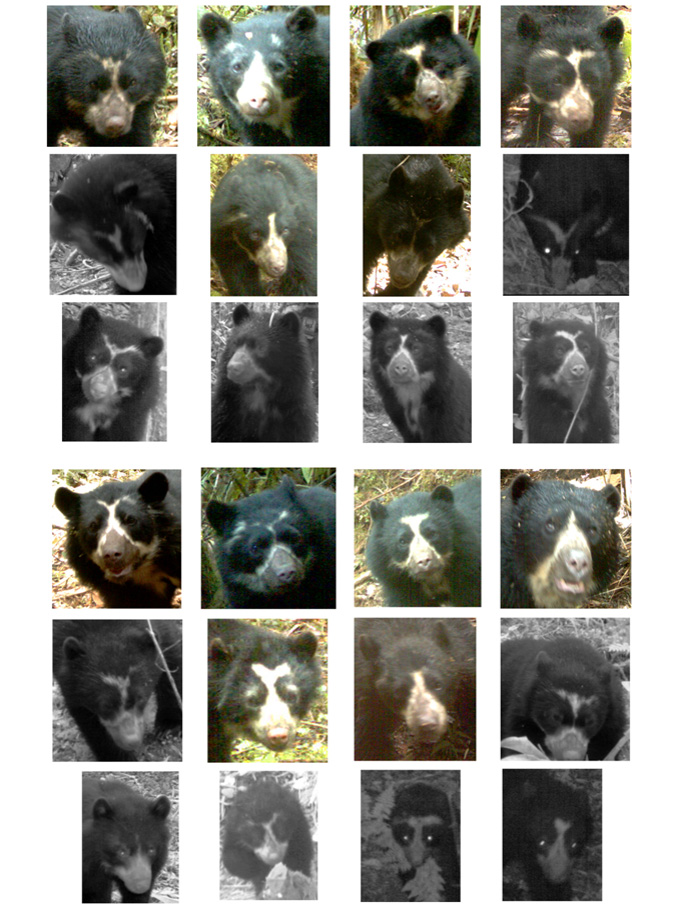
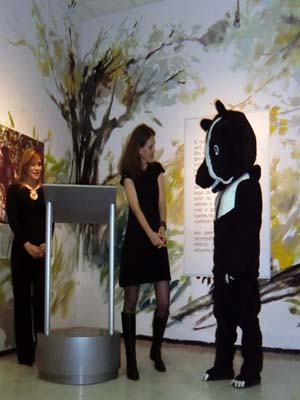
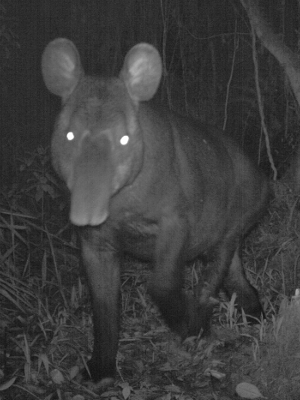




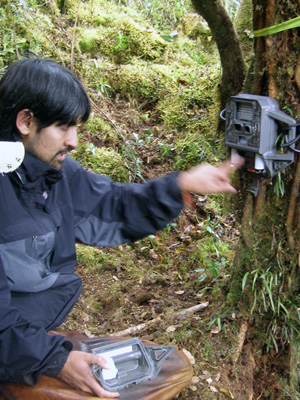
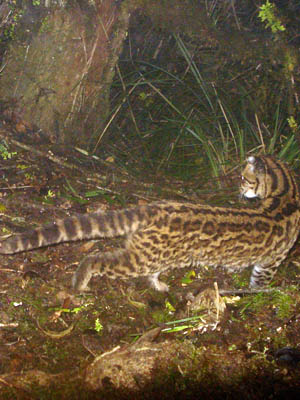
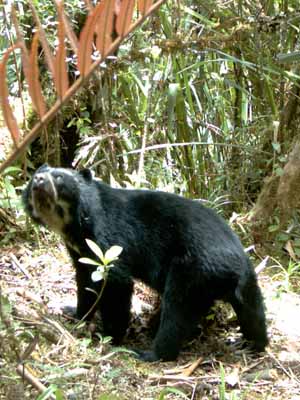
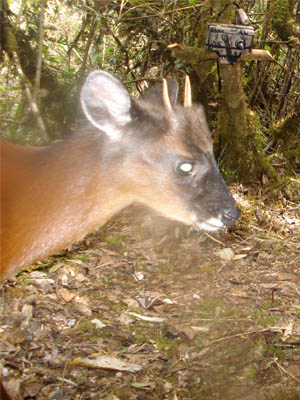
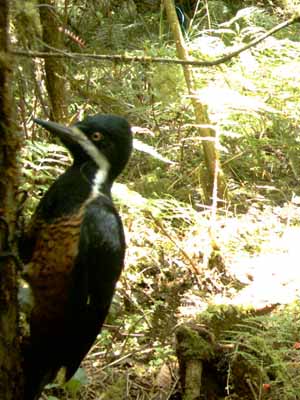
The Don Oso Program
Introduction

FCT's Don Oso Program aims to protect the Andean, or spectacled bear (Tremarctos ornatus) and its diminishing habitat within and near the southern boundary of Sangay National Park. Launched in 2002, the Program is a collaboration between FCT, the Carnivore Coexistence Lab at the University of Wisconsin-Madison, USA, and communities in the Nudo del Azuay. It includes four major initiatives: 1) environmental education and bear awareness; 2) scientific research on bear biology; 3) capacity building for locals as para-biologists; and 4) interventions to reduce human/wildlife conflicts.
The Don Oso Education Program
The Don Oso Program published the 130-page Don Oso Visits My School workbook in 2011. Using the endangered Andean Bear as a mascot, this interactive workbook builds math, geography, and literacy skills while teaching environmental ethics and conservation to the next generation of local landholders. ¨These hands-on materials aim to educate a future generation of land stewards about the importance of local ecosystems, giving them information and tools to protect endangered species like the Andean bear¨ says author Renata Márquez.

"Hello girls and boys! My name is Don Oso
and I´m a Spectacled bear. Want to learn
more about the places I live and the food
I eat? Let´s go!"
Introduction
Unit 1: Bears of the world
Unit 2: The Andean bear and its relationship with communities
Unit 3: Andean bear habitat
Unit 4: Andean bear biology
Unit 5: Ecological importance of the Andean bear
Unit 6: Researching the Andean bear
Unit 7: Main threats to the Andean bear
Glossary of terms
Bibliography and Credits
Teacher Activity Guide
Scientific Research
Starting in 2008, the Don Oso Program used remote cameras to photo-capture the elusive Andean bear in the region's montane cloud forests. The first year of fieldwork revealed that unique facial patterning made it possible to identify individual bears. In the second year, we improved upon our initial identification by capturing photos of bears from more than one angle. Most recently in 2011/2012, the study was expanded to detect individual bears far from their original photo-capture site and helped us better understand bear use of different habitats found on public and private properties.
Equipment
We use two different brands of remote cameras: one with digital cameras inside casing and the other a single integrated photographic unit.
Methods
Our program uses successful camera-trapping techniques developed to study cryptic carnivores around the world. Sites are selected based on the presence of existing bear sign in the immediate area (food remains, claw marks, scat and/or footprints) and are located along well-used wildlife trails inside montane forest.
During our first field season in 2008 researcher Becky Zug of the Carnivore Coexistence Lab (CCL) at the University of Wisconsin-Madison installed one camera per station and used commercial lure to attract Andean bears to the trap sites, positioning them in front of the cameras to capture their unique facial patterning. In 2009,Taylor Jones, also of CCL, installed two cameras per station to improve the probability of individual identification and continued to use commercial lure. These same methods were used during our third field season in 2010/2011.
Results
From 2008 through 2011, we logged over 5,000 camera nights at twenty sites above 8,200 feet (2500 m) in southern Sangay National Park and captured dozens of photos of at least 25 individual Andean bears. Cameras photo-captured a suite of additional large and small mammals including: the little red brocket deer (Mazama rufina) and oncilla, (Leopardus tigrinus), both classified as vulnerable to extinction in Ecuador, as well as the puma (Felis concolor), mountain coati (Nasuella olivacea), margay (Leopardus wiedii), mountain paca (Cuniculus taczanowskii), Andean fox (Lycalopex culpaeus), Andean white-eared opossum (Didelphis pernigra), white-tailed deer (Odocoileus virginianus ustus), and tayra (Eira barbara). Many of these sightings expand upward known ranges in Ecuador and in the case of the tayra expand known global ranges.
Local Capacity Building
The Don Oso Program involves park officials, community para-biologists, and landowners in joint training and conservation planning that: (i) monitors wildlife in and around titled lands within southern Sangay National Park, (ii) communicates results to community, county and provincial leaders, and (iii) uses non-lethal methods to reduce conflicts with wildlife.
A 2009-2011 collaboration between CELEC EP Unidad de Negocio Hidropaute, the Ministry of Environment, and FCT trained ten community members as para-biologists. They included representatives from seven indigenous and mestizo communities found within or directly adjacent to Sangay National Park. None had previous professional training; in fact, most had only completed sixth grade. The formal training included workshops offered by international and regional experts. The hallmark of our approach, however, was intensive side-by-side work in the field. FCT offered 120 hours of formal training annually, pairing each hour of formal training with an average of 8 hours of follow-up in the field. Over these past two years, FCT and community para-biologists jointly monitored camera traps; developed the Don Oso visits my school curriculum; led education activities in 7 local schools; trained over 200 local teachers and supervisors in the implementation of the Don Oso curriculum; and assisted in the response to reports of human/wildlife conflicts.
This experience demonstrates that facilitating knowledge transfers among diverse actors -- international experts, Ecuadorian scientists, local parabiologists, and communities -- enriches everyone's understanding of the challenges, and facilitates the identification of site-specific solutions.
Future work aims to train Sangay National Park's new park guards as para-biologists and involve senior park staff in conservation planning within the park's private and public lands. For more information on capacity building, please click
here.
Conflict Mitigation
National parks can be difficult to live alongside when far-ranging wild animals explore neighboring private properties. Sangay National Park is no exception. It is the largest wild area in Ecuador's eastern Andes and is one of only seven protected areas in Ecuador large enough to sustain a viable population of Andean bears. The bears are principally herbivorous and consume plants such as orchids, wild fruits, and bromeliads. The bears will attack cows, however, if the opportunity exists. Over the past 10 years, landholders in the Nudo del Azuay have reported an average of 3-4 bear attacks on cattle per year. Landowners who lose cattle to wildlife often hunt problem bears, ensuring that they will not return.
The Don Oso program seeks to replace the traditional private retaliation against wildlife with non-lethal alternatives. These options may include modification of husbandry to reduce vulnerability to wildlife; for example, pasturing cows closer to human dwellings rather than in distant páramo grasslands. It may also include the installation of defenses and deterrents like fences or night corrals. A small group of landowners has installed one or more deterrents, but most find these non-lethal deterrents too costly to implement.
In 2011 as a response to ongoing reports of bear attacks on cattle, FCT installed remote cameras on trails that lead from the forest to affected pastures to investigate whether bears returned to the same places. The cameras documented one feral dog attack on a cow (initially attributed to a bear), and captured photos of numerous small mammals: páramo fox, striped hog-nosed skunk, mountain coati, little red brocket deer, puma, mountain paca, Andean white-eared opossum, and two small felines. The cameras did not record any repeat bear visits.
Lethal retaliation following bear attacks on cattle continues to be a threat to the long-term survival of the Andean bear. Our work suggests that although the attacks are infrequent, they cause significant economic losses. FCT remains committed to working with local landowners to implement deterrents which better protect private property at the same time as securing the long-term protection of the Andean bear.
Available reports and studies related to this program
Achig, L. (2009). "Análisis del hábitat del oso andino (Tremarctos ornatus) en el bosque siempreverde montano y perspectiva comunitaria del conflicto humano-oso, Parque Nacional Sangay, Ecuador". Master's Thesis. Universidad Nacional De Costa Rica, Instituto Internacional en Conservación y Manejo de Vida Silvestre. Heredia, Costa Rica. In Spanish.
Jones, T. R., B. Zug, and A. Treves. (2010). "Credible Conservation: Using Biodiversity Monitoring to Support Incentive Programs that Protect Endangered Wildlife". Land Tenure Center Tenure Brief 13. [Also available in Spanish as ¨Conservación Creíble: Usar el monitoreo de biodiversidad para apoyar los programas de incentivos que protegen la vida silvestre en peligro¨.]
Jones, T. (2010). "Detection probability and individual identification of the Andean Bear (Tremarctos ornatus) using camera trapping methods". Master's thesis. University of Wisconsin-Madison. Madison, Wisconsin.
Márquez Alvarado, R. (2011). Proyecto Don Oso visita mi escuela: Cartilla sobre la Biología y Ecología del Oso de Anteojos para niñas y niños de cuarto, quinto, sexto y séptimo de básica. Fundación Cordillera Tropical. 1era. Edición. 132pp. Cuenca. Ecuador.
Márquez Alvarado, R. (2011). Programa Don Oso visita mi escuela. Cartilla sobre la Biología y Ecología del Oso de Anteojos para profesores, profesoras y educadores ambientales de cuarto, quinto, sexto y séptimo de básica: Guía de Aplicación. Fundación Cordillera Tropical. 1era. Edición. 86pp. Cuenca. Ecuador.
Sanchez, K., Cuesta, F., Remache, G., y Peralvo, M. (2003). Disponibilidad del hábitat del oso andino en la porción centro y sur del Parque Nacional Sangay y su Área de Influencia, Ecuador. Quito, Ecuador: Ecociencia.
Schloegel, C., T. Jones, B. Zug, L. Achig, and A. Treves. (2011). Don Oso Program Develops Participatory Monitoring Protocol for Andean Bears in Southern Sangay National Park, Ecuador. International Bear News, 20(2):23-25.
Treves, A., and C. Schloegel. (2010). "Monitoring and enforcing Payment for Ecosystem Services Programs: Lessons Learned". Land Tenure Center Tenure Brief 14. [Also available in Spanish as "Monitoreo e implementación de Programas de Pagos por Servicios de Ecosistemas: Lecciones Aprendidas".]
Treves, A., R.B. Wallace, and S. White. (2009). "Participatory planning of interventions to mitigate human-wildlife conflicts". Conservation Biology, 23(6):1577-1587.
Treves, A., and S.M. Jones. (2009). "Market Financing for Biodiversity Conservation and Strategic Tradeoffs for Wildlife-Friendly Eco-Labels". Land Tenure Center Tenure Brief 10. [Also available in Spanish as "Financiamento de mercado para la conservación de biodiversidad y ventajas y desventajas estratégicas de las eco-etiquetas amigables con la vida silvestre."]
Treves, A. (2007). "Balancing the Needs of People and Wildlife: When Wildlife Damage Crops and Prey on Livestock". Land Tenure Center Tenure Brief 7. [Also available in Spanish as Treves, A. 2007. "Mantenimiento del Equilibrio entre la Fauna y las Necesidades de la Gente: Cuando la Fauna Perjudica los Cultivos y se Alimenta del Ganado."
Van Horn, R., Zug, B., and Velez-Liendo, X., and Paisley, S., and LaCombe, C. (2015). Human visual identification of individual Andean bears Tremarctos ornatus. Wildlife Biology 20(5):291-299.
Van Horn, R., Zug, B., Appleton, R., and Velez-Liendo, X., and Paisley, S., and LaCombe, C. (2015). Photos provide information on age, but not kinship, of Andean bear. PeerJ 3:e1042; DOI 10.7717/peerj.1042
Zug, B. (2009). "Individual Identification and Habitat Use of Andean Bears on Private Lands in the Ecuadorian Andes." Master's thesis. University of Wisconsin-Madison. Madison, Wisconsin.
Zug, B., L. Achig, C. Schloegel, and A. Treves. (2011). "Community engagement, para-biologists training and Andean bear conservation in and around southern Sangay National Park, Ecuador" [abstract]. In: Program and Abstracts of the 20th International Conference on Bear Research and Management; July 17-23; Ottawa, Canada.
Press
Alvarado, M. (2014, 16 febrero). Las zhibrecabras y los cabeza de mate tienen nuevo hogar. Hoy. Retrieved February 18, 2014 from http://www.hoy.com.ec/noticias-ecuador/las-zhibricabras-y-los-cabeza-de-mate-tienen-nuevo-hogar-600981.html
Alvarado, M. (2013, 9 sept). Héroes anónimos tras la pista de los osos. Hoy. Retrieved September 10, 2013 from http://www.hoy.com.ec/noticias-ecuador/heroes-anonimos-tras-la-pista-de-los-osos-590304.html
DWCF Announces 2012 Conservation Heroes. (sin fecha). The Walt Disney Company. Retrieved December 18, 2012, from http://thewaltdisneycompany.com/content/dwcf-announces-2012-conservation-heroes
El oso andino encuentra protectores. (2013, Mayo 26). El Universo. Retrieved Sept. 10, 2013 from http://unvrso.ec/00075DK
Entregan importante galardón. (2013, Mayo 21). Empresa Pública Municipal de Agua Potable, Alcantarillado y Saneamiento Ambiental del cantón Azogues - EMAPAL EP. Retrieved Sept. 10, 2013 from http://www.emapal.gob.ec/index.php?option=com_content&view=article&id=353:entregan-importante-galardon&catid=44&Itemid=107
Exposición dedicada a los osos de anteojos (2013, Febrero 28). El Tiempo, Retrieved Sept. 10, 2013 from http://www.eltiempo.com.ec/noticias-cuenca/116647-exposicia-n-dedicada-a-los-osos-de-anteojos/
Fundación Cordillera Tropical, Landívar, T. (2013). El Oso de anteojos, Símbolo de los Andes [Brochure]. Cuenca, Ecuador: Ministerio de la Cultura.
Guargabosques nominados "Héroes de la Conservación" (2013, mayo 16). El Heraldo del Cañar. Retrieved Sept. 10, 2013 from http://www.heraldodelcanar.com/2013/05/16/guargabosques-nominados-heroes-de-la-conservacion
Lituma, M. (2013, agosto 28). La vida de 27 osos de anteojos en el Sangay se rastrea con 35 cámaras. El Comercio. Retrieved Aug. 28, 2013 from http://www.elcomercio.com/sociedad/Osos-anteojos-bosques-ParqueNacionalSangay-Canar-peligro-extincion-conservacion-proteccion_0_982701736.html
Los guardias de los osos (2013, mayo 2). Diario Súper - Cuenca. Retrieved May 5, 2013 from http://www.super.com.ec/revistas/cuenca/2013-06-02/index.html#/4/
Nelson Institute partnership in Ecuador honored (2012, diciembre 18). The Nelson Institute for Environmental Studies, University of Wisconsin-Madison. Retrieved December 18, 2012, from http://www.nelson.wisc.edu/news/news-details.php?e=1649
Peek, J. (2011, August 17). Caught on tape: Researchers track, help protect elusive bear in Ecuador. The Nelson Institute for Environmental Studies, University of Wisconsin-Madison. Retrieved August 23, 2011, from http://nelson.wisc.edu/news/news-details.php?e=1320
Plan para preservar el oso de anteojos (2012, Mayo 10). El Mercurio.
Revilla, J. (2013, Sept 23). Fundación Cordillera Tropical trabaja en conservación ambiental y protección de osos de anteojos. Noticiero Gama TV. Retrieved Sept. 26, 2013 from http://www.youtube.com/watch?v=52Hhhy_UShc
Soto, Y. (2013, Julio). Remigio Orellana, miembro de la Microempresa Asociativa de Guardaparques para la Conservación de la Naturaleza y promotor ambiental del Programa Don Oso de la Fundación Cordillera Tropical (FCT). The Eco-Index of Rainforest Alliance. Retrieved August 13, 2013 from http://ecoindexesp.wordpress.com/2013/07/30/remigio-orellana/ [Disponible también en Inglés como "Remigio Orellana, member of the Micro-business Association of Rangers for Nature Conservation and environmental advocate for the Fundación Cordillera Tropical (FCT) Program Don Oso"].
Soy un oso de anteojos (2012, Enero 22). El Mercurio, p. 2B.
Telecuenca Canal Universitario (Productor). (2013, Marzo 1). Exposición ¨El Oso de anteojos, Símbolo de los Andes¨ [Telecuenca]. Retrieved Sept. 10, 2013 from http://www.youtube.com/watch?v=Z8xl8e89mho
Vélez, S. (2013, Mayo 27). Premio internacional por cuidado del medio ambiente. Programa "De mujer a mujer" y "N'Boga", Telerama. Retrieved Sept. 10, 2013 from http://www.youtube.com/watch?v=AhBFnYelbNw&feature=share&list=LLKE1l6zLU1BHYuOHR3zdJ2w